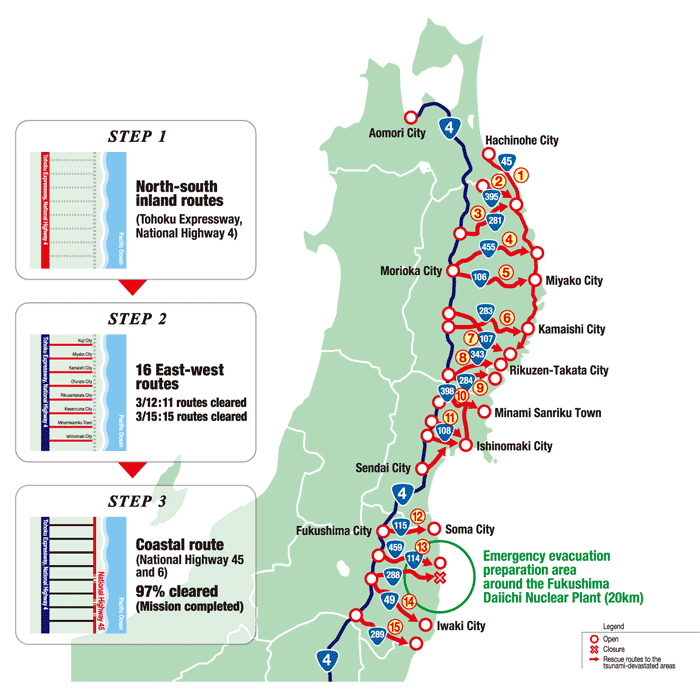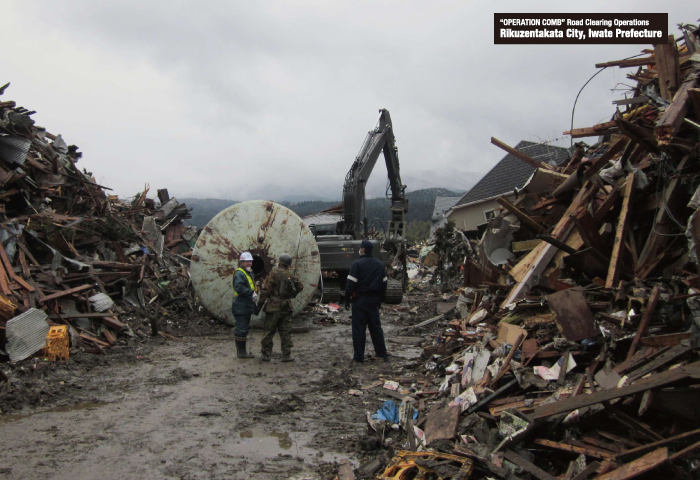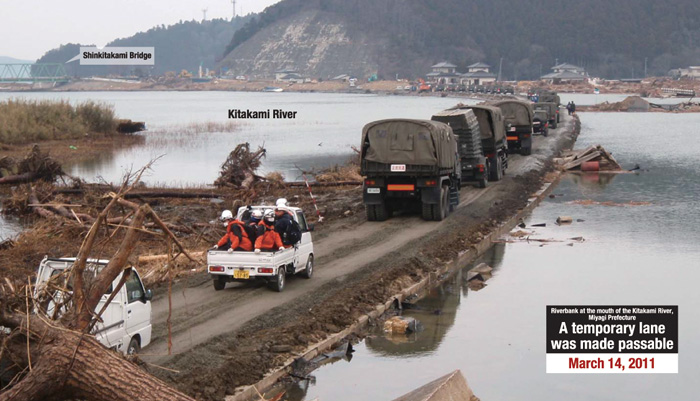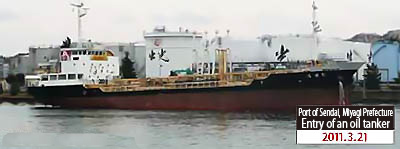From the day following the earthquake, “road clearance” works (Operation “Teeth of a Comb”) were started. The road clearance works secure a route just wide enough for a car to get through.
In the midst of fear of aftershocks and another tsunami, the site managers of construction companies and the road administrators considered the road clearance works to be their mission. They wanted to do anything to help out the affected area. They determined to undertake the road clearance works, and dedicated themselves to the works.
The road clearance works were completed much earlier than the original schedule, thanks to the collaboration with the JSDF, the police, and both prefectural and municipal organizations concerned, which took care of the bodies found during the clearance works.
2. Road Clearance
Operation “Teeth of a Comb” was carried out.
A mission to clear the Road of Life. No moment to lose.
Operation “Teeth of a Comb” was a road clearance operation to secure rescue and relief routes on a number of national highways extending from inland toward the Pacific coastal area of Tohoku. The operation was named after the shape of the road network under Operation, where the Tohoku Expressway and Route 4 run inland Tohoku from north to south, and a number of debris-covered roads to be cleared extend from the expressway and Route 4 toward the coast.
The inconceivably huge tsunami devastated the areas along the Pacific coast of Tohoku, leaving many areas isolated by debris-covered roads and swept bridges. Immediately after the earthquake, the Bureau leaders and staff gathered in the Disaster Risk Management Office of the MLIT Tohoku Regional Bureau.
Communication with the road and highway offices and braches was established soon to gather information on the damage, and the strategy had been worked out. Operation “Teeth of a Comb” was immediately carried out to clear the roads and secure the Road of Life.

11 routes were secured in two days.
We cleared debris from the roads, removed bumps, and secured rescue and relief routes.
Secure routes to save lives of many injured people, and to deliver relief supplies to the disaster-affected people.
Under Operation “Teeth of a Comb” that was worked out immediately after the earthquake, the “road clearance” works were carried out. What are the road clearance works? They clear debris or other obstructions from the road.
The prefectural office staff, the members of the JSDF, the workers of local construction companies, and the MLIT Tohoku Regional Bureau staff - they worked as a team, and pushed their way through the debris. In the midst of fear of aftershocks and tsunami warnings, they dedicated themselves to the work, just “hoping to save as many lives as possible”. On the March 12, the following day of the earthquake, 11 routes were secured; then, 15 routes on March 15, allowing emergency traffic, including ambulances, the police, and the JSDF.
Medical teams were also able to reach the affected areas. Relief supplies were delivered to where needed.

Levees became emergency transportation routes.
Priority of restoration works was given to the river road levees, which facilitated transportation of emergency relief supplies.

Thousand hundred meters of the river road levee was swept away in the mouth of the Kitakamigawa River (Kamaya area, Ishinomaki).
As a result, some villages were isolated, and rescue operations were suspended.
Priority of restoration works were given to the works to secure a space just wide enough for a car to get through. On March 14, temporary one-lane traffic was restored.
This has facilitated traffic of emergency vehicles and transportation of emergency relief supplies, leading to greater support to the affected areas.
Restoration of similarly affected river road levees was also undertaken, while priority was given to the restoration of traffic.

By March 23, ten major ports became accessible.
Channel clearance, which was to remove obstructions in the harbors, began three days after the earthquake.

After the tsunami warning and advisory were lifted in the evening of March 13, channel clearance, which was to remove containers, cars, fishnets, etc. drifted from shore or sunk in the sea, began from early morning of March 14.
Priority of channel clearance works was given to the Port of Miyako, Kamaishi, and Sendai-Shiogama, the biggest port in Tohoku, because transportation of relief supplies was considered the most important. Clearance works were later expanded to include others major ports. On March 16, the fifth day after the earthquake, a ship with emergency relief supplies on board entered the Port of Kamaishi. By March 23, temporary safe channel had been secured in ten affected ports, allowing the ports to receive emergency relief supplies by marine transportation.
On March 21, the tenth day after the earthquake, the first oil tanker entered the Port of Sendai-Shiogama, relieving the shortage of fuel oil.

The number of ships entering the ports between March 21 and 31

| March 21 - 26 2,000 kl class tanker 8 |
Fuel oil about 16,000 kl |
| March 27 - 31 5,000 kl class tanker 12 |
Fuel oil about 37,000 kl |
| Total about | 53,000 kl |
